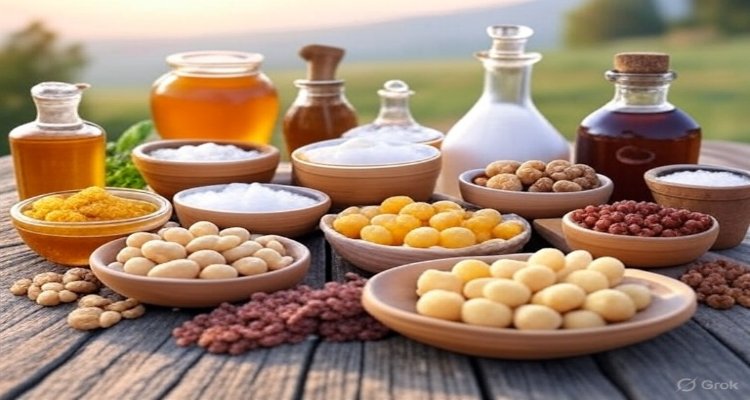The Foods That Naturally Preserve Themselves for Centuries
From honey sealed in Egyptian tombs to salt-cured fish, some foods can last centuries without spoiling. Here’s the science and history behind them.
Introduction: Time Capsules on a Plate
In 1922, when archaeologists opened King Tutankhamun’s tomb in Egypt, they discovered something astonishing alongside gold and jewels—jars of honey, still perfectly edible after more than 3,000 years. This wasn’t a fluke of history. Some foods are nature’s own preservation miracles, capable of resisting decay for centuries without refrigeration, chemicals, or modern packaging. But how is it possible for food, the very substance we associate with spoilage, to last almost forever?
Context & Background: The Ancient Quest for Longevity
Long before the refrigerator, humans experimented with ways to keep food fresh—smoking, fermenting, drying, and salting. Yet, certain foods defy time even without intervention. Ancient civilizations recognized their durability, using them not just for sustenance but also in rituals, trade, and medicine. Today, scientists understand the chemistry behind this resilience: it often comes down to unique structures, natural antibacterials, or environments inhospitable to microbial growth.
Main Developments: Foods That Stand the Test of Time
Honey: The Eternal Sweetener
Honey’s low water content and high acidity create an environment where bacteria and fungi simply cannot thrive. Sealed in a jar, it can last indefinitely. Archaeologists have sampled honey from ancient Egyptian tombs and found it as golden and sweet as the day it was stored.
Salt: The Original Preservative
Salt doesn’t just keep—it keeps other foods. This mineral, formed over millions of years, has no expiration date. Civilizations mined it, traded it, and relied on it to preserve meat and fish long before iceboxes existed. Its ability to draw out moisture makes it impossible for most microbes to survive.
Dried Legumes and Grains
Wheat, rice, lentils, and beans—when stored properly in airtight containers—can last for decades, even centuries. Archaeologists in China have uncovered ancient rice grains preserved in sealed vessels, while Roman granaries revealed wheat that was still structurally intact.
Vinegar: Preservation Through Fermentation
Acidic, antimicrobial, and self-stabilizing, vinegar has been used since Babylonian times. It not only keeps itself but also extends the shelf life of vegetables and meats through pickling. A bottle of vinegar in your pantry could theoretically last as long as civilization itself.
Sugar: Crystals That Lock Out Decay
Like honey, granulated sugar has an incredibly long shelf life when stored in dry conditions. Its crystalline structure binds water, leaving no room for microbial life. Ancient sugar loaves stored in clay jars have been found virtually unchanged after hundreds of years.
Alcohol: Wine, Mead, and Spirits
Not all alcohol improves with age, but many can endure centuries. Mead, the honey-based drink enjoyed by Vikings, has been found in sealed vessels and remains safe to consume. Distilled spirits, thanks to their high alcohol content, are virtually timeless.
White Rice and Hardtack
While modern palates might not crave it, hardtack—an extremely dry cracker made of flour, water, and salt—was a staple for sailors and soldiers for centuries. With almost no moisture, it could last indefinitely if kept dry. White rice, unlike brown rice, can remain edible for 20–30 years in sealed containers.
Expert Insight: Why These Foods Survive
“Microorganisms need three things to grow: moisture, moderate temperature, and nutrients,” explains Dr. Lina Robertson, a food microbiologist at Cornell University. “Foods like honey, salt, and sugar remove at least one of those variables, creating an environment where spoilage simply can’t happen. They are, in essence, microbial deserts.”
Historians also point to the role these foods played in shaping trade routes. Salt caravans, honey cultivation, and grain storage were central to the rise of civilizations. The foods’ longevity wasn’t just culinary—it was economic and political.
Impact & Implications: Lessons for a Modern World
In today’s age of “best by” labels and food waste concerns, these naturally preserved foods offer a reminder of how resilient nature can be. Emergency planners and survivalists still recommend stocking honey, rice, and dried beans for long-term preparedness. Meanwhile, researchers studying ancient food preservation methods are rethinking sustainable alternatives to modern refrigeration and chemical additives.
For archaeologists, each discovery of edible food in ancient ruins is more than a curiosity—it’s a direct connection to the diets and lives of our ancestors. For consumers, it’s a reminder that not all food is fleeting.
Conclusion: Eating Across Centuries
From honey sealed in a pharaoh’s tomb to salt mined millions of years ago, certain foods endure as edible time capsules. They tell stories of survival, trade, and ingenuity, reminding us that preservation is as old as civilization itself. The next time you drizzle honey into your tea or sprinkle salt over a meal, you’re tasting not just sweetness or seasoning—but history itself.
Disclaimer : This article is for informational purposes only. While many of these foods have been proven to last indefinitely under proper conditions, storage environments can impact safety. Always check for contamination or spoilage before consuming.











